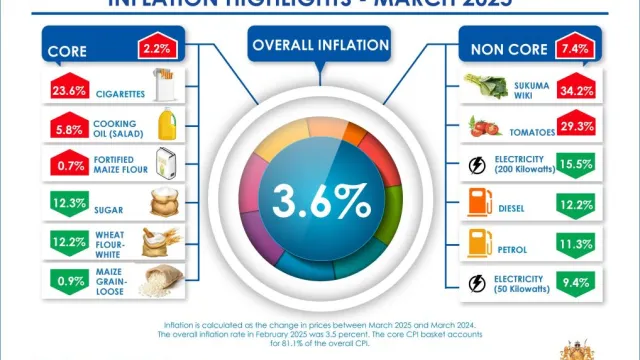Inflation edges up to 3.6% in March, driven by food costs

In March, the food and non-alcoholic beverages category recorded a 6.6 percent price surge, with notable increases in staple items.
Kenya’s inflation rate rose slightly to 3.6 percent year-on-year at the close of the first quarter, up from 3.5 percent in February, according to data by the Kenya National Bureau of Statistics (KNBS). On a monthly basis, inflation stood at 0.4 percent, reflecting modest price pressures in the economy.
The overall inflation was influenced by core inflation, which contributed 2.3 percentage points, while non-core inflation added 1.3 points, KNBS Director General Macdonald G. Obudho said in a statement. The rise was primarily driven by increases in food and transport costs over the past year.
Key drivers of inflation
In March, the food and non-alcoholic beverages category recorded a 6.6 percent price surge, with notable increases in staple items. Between February and March, the cost of sukuma wiki (kales) rose by 6.2 percent to KES88.51 from KES83.32 per kilo, Irish potatoes by 4.5 percent, and loose maize grain by 3.3 percent. However, prices of sugar and beans saw marginal declines of 0.7 percent and 0.2 percent, respectively.
The transport index also increased by 1.5 percent month-on-month, largely due to a 3.9 percent hike in local flight prices. Meanwhile, petrol and diesel prices remained stable during the period.
Housing and utilities show mixed trends
The housing, water, electricity, gas, and other fuels index registered a slight 0.2 percent increase, attributed to a 0.2 percent rise in gas/LPG prices. Additionally, electricity costs for 50kWh and 200kWh rose by 1.0 percent and 0.9 percent, respectively. However, the broader category saw a 0.8 percent decline in prices over the year, offering slight relief to households.
Inflation Measurement
The Consumer Price Index (CPI), which tracks the cost of a fixed basket of goods and services, uses February 2019 as its base period. The inflation rate is derived from monthly retail price surveys conducted in urban areas across 50 data collection zones.
The three major expenditure categories—food, housing, and transport—account for over 57 percent of the total weight in Kenya’s inflation calculation.
While inflation remains within the Central Bank of Kenya’s target range (2.5 percent-7.5 percent), the uptick in food and transport costs continues to strain household budgets.





